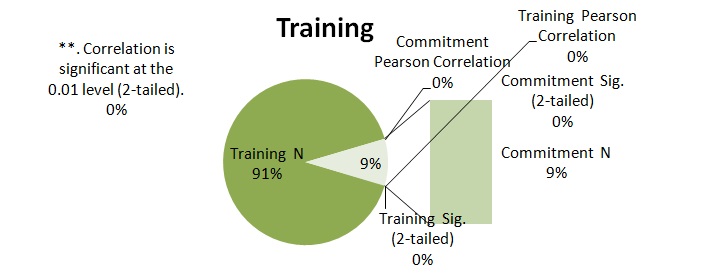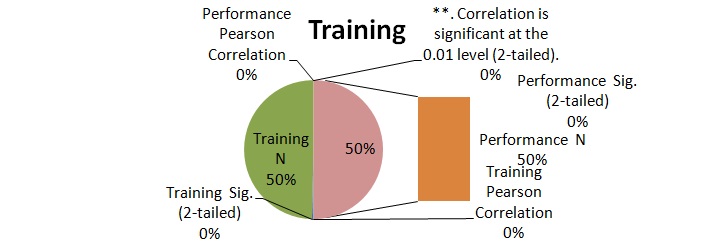Introduction
Background of the Study
SEHA, which is health in Arabic, is one, of the organisations today that wants to improve the performance of their employees to increase productivity, service delivery, competitiveness, and to achieve the performance goals and objectives that have been set through the training and development functions (Hajat & Harrison, 2010). The rationale is that employees are the most important organisational assets who play a significant role in the success of the organisation. However, employees cannot make distinct contributions towards the success of the organisation if they are not equipped with the right knowledge and skills that are achieved through training and development programs, which form part of the functions of the Human resource department.
That is the case with the SEHA, which is a “joint stock company created to assume the role of hospital and clinic operator and whose mission is to deliver world class medicine to the residents of Abu Dhabi” (Hajat & Harrison, 2010, p.3). The company deals in the provision of quality and cost effective health care service delivery to the local people and others from other parts of the world. SEHA “owns and operates 15 health care facilities, 2,600 licensed beds, and more than 55 Ambulatory and Primary Health care Clinics. SEHA is one of the largest employers in the Middle East with around 15,000 employees” (Hajat & Harrison, 2010, p.3). However, because of the scope in the provision of health care services, the institution, under the function of the human resource management wants to improve the provision of services to remain competitive in the local and international market by focusing on training and development of employee skills. Training and development are the key components that organisations value because such programs enable employees to become part of the competitive advantage of the organisation in all its core areas of operations.
The human resource department executes training and development as one of the core functions through the use of various programs such as workshops, coaching, use of mentorship programs, and the use of educational programs. According to Dessler (2003), training and development programs help to improve employee intrinsic and extrinsic motivation so that the best in them can be brought out. In addition, the training and development programs have previously been regarded as the tools to improve employee attachments to the organisation and most human resource managers evaluate the success of an organisation on its ability to attract highly qualified and trained personnel, however, the success of an organisation depends on its ability to properly coordinate the workers by aligning them with the goals and objectives of the organisation. Armstrong and Taylor (2014) argue that the study is an important problem for scholars to tackle to find solutions on how to inspire employees to develop the kind of commitment to achieve organisational objectives. The greatest challenge is to the Impact of training and development on organizational performance. The study leads to the question on how does training and development improve organizational performance? What is the correlation between training and development on the performance of an organization? To answer the questions, the study was conducted with the following objectives as the guiding framework.
Statement of the Problem
Many organizations today have realised the importance of investing in the training and development of employees to improve service delivery, the quality of services, employee productivity, and to increase motivation and commitment towards the organisation. Despite the realization, the human resource function needs to establish the correlation between training and development and its impact on the performance of the core functions of the organization. This study aims to address the problem of employee training and development and the effects such elements have on their commitment to the organisation. The study was built on previous studies that show how compensation, pay packages, and performance appraisal contribute to organizational performance.
Aims and Objectives
The aim of the study is to establish the correlation between employee training and development and the effects on the performance of the organisation.
Objectives
The research objectives include:
- Determine how organizations implement the training and development program
- Investigate how to achieve organizational commitment
- Investigate the factors that affect the performance of the organization
- Determine the factors that underpin organizational development
- Conduct the case study on SEHA
Scope of the Project
The study was conducted to investigate the impact of employee training and development on organisational performance by focusing on training and development as the core functions of the human resource department of the organisation.
Focus of the Study
The study focused on establishing the purpose of training programs, the phases in the training and development program, and the training and development techniques that can be applied to enhance employee commitments and ho such key areas contribute to the improvement of organizational performance.
Significance of theS
The study is beneficial to organisations to determine the best strategies and antecedents to achieve higher employee commitments and better organizational performance through customised training and development programs.
Hypothesis
The core competencies of an organization can be increased by implementing a training and development program to enhance employee knowledge and skills.
Research Questions
The following research questions provide the paradigm on which the hypothesis was proved.
How does training and development influence employees’ commitment in an organization? If so, what role does it play and how does it affect training and development? It has been established in academia and other scholarly articles that the indicators of the level of commitment that employees show to an organization can be evaluated on absenteeism, the execution of the roles and responsibilities assigned an employee, withdrawal from the duties and responsibilities assigned an employee, and the job performance. To address the research questions, the study undertook an investigation on the link between training and development and the job performance.
How to Solve the Research Problem
The study was informed by a review of the facts established by different researchers in the discipline of human resource management with a specialized focus on the effects of the antecedents of training and development elements on employee performance and organizational success. Underscoring the study are the factors that influence the commitment of employees towards the aims and objectives of the organization (Armstrong & Taylor, 2014). Researchers argue that most organisations through the human resource department implement training and development programs with an aim of improving the quality of products and services. However, little research has been done to study the approaches necessary to utilise employee through eh training and development programs to facilitate employee commitment in using their skills and knowledge to innovate and develop new products and services to the advantages of the organisation. Evidence of a paradigm shift occurred because of the new perspectives human resource managers develop about employee training and development programs and how such programs contribute to the success of the organization.
Evidence derived from the use of both qualitative and quantitative paradigms formed the basis of the primary research findings. The rationale to use mixed research methods was that it was informed by the use of data derived from both qualitative and quantitative paradigms was that the researcher was able to derive sufficient information on the impact of the training and development programs and the resulting level of employee commitment towards the organisation. It has been established that the qualitative paradigm enables a detailed probe on the problem to answer the questions on “why” and “how” of a research question. Qualitative paradigms provides an exploratory and descriptive focus of the study, emphasizes on the human as the data collection instrument, and led to a more realistic feel of the problem and the solutions (Feilzer, 2010). In addition, it was possible to interact with the subjects of the research in their own terms, which made it possible to obtain a collective view of the phenomena under investigation.
Quantitative paradigm was used to collect numerical data for statistical analysis by administering questionnaires on the respondents. The questions provided answers to fill the gap that exists in academia on the impact of the training and development programs on the performance of the organisation (Feilzer, 2010). The gap in knowledge has been identified in the failure of previous researchers on the potential of training and development as a tool to improve employee commitment to the organization.
The study was to investigate the potential of using training and development programs to improve employee commitments that leads to better organizational performance. Typically, performance is one of the key indicators of effectiveness of the training and development program because those employees who show higher levels of commitment have been shown to work harder to improve organisational performance (Dessler, 2003; Harzing & Pinnington, 2010; Ivancevich, 2010; Armstrong & Taylor, 2014). Here, the study established a strong correlation between training and development and organizational performance, the basis for the conclusion that commitment underpins better organizational performance. The key indicators of performance committed employees include how employees manifest themselves towards executing their roles and responsibilities.
Expected Outcomes
It was expected that the study was to provide the foundation for determining how the training and development programs affect the performance of an organisation based on the strategic approach of improving their commitment to the organizational goals and objectives, and how commitment and performance are related. The rationale is that training and development programs enable employees to acquire better skills and knowledge to execute their roles and responsibilities effectively and efficiently (Armstrong & Taylor, 2014). It was expected that the study could crystalize how organizations use the training and development programs to influence employee attitudes towards their commitment to the organization.
The study findings show that using the training and development programs effectively leads to better skilled and trained employees who have a high likelihood of staying on the job instead of withdrawing because they lack the right skills. In addition, training increases employee confidence in the job by enhancing employee’s skills, knowledge, and increasing morale (Yousef, 2000). Training helps to create a better image, enhanced decision making skills, increases employee job satisfaction and retention, enables employees to be confident when attempting new tasks, and helps the management to solve work related problems and group conflicts. According to Ivancevich (2010), training and development programs provide employees with job satisfaction and the desire to work hard by reducing the level of absenteeism, increasing self-esteem, and enabling them to acquire the necessary skills to effectively handle repetitive tasks.
Ivancevich (2010) proposal on the additional areas for organisations address through the training and development programs include empowering employees with the right skills and knowledge to communicate effectively, resolve conflicts among the team members, enhance coordination among employees and the management, and enhance and motivate employees to work in effective teams.
Assumptions
The study was based on the assumptions that the human resource department was devoted to the training and development program, which could help the management to improve employee commitment to the organisation. Commitment was assumed to increase employee involvement in organisational roles and tasks leading to better organizational performance. Here, performance has a strong correlation with the training and development program and the efficient execution of roles and tasks.
Research Limitations
The study encountered limitations in the context of the availability of time and how to determine honest answers to the research questions.
Literature Review
Training
Organisations use employee training program to modify their attitudes and behavior towards the work related tasks to produce the desired change. Training is an interventional strategy to elucidate best learning outcomes based on aptitude, motivation, and self-regulations and individual differences. Specifically, training programs that focus on individual differences have been shown to be effective in inculcating the capabilities required for better performance (Al Junaibi, Abdulle, Sabri, Hag-Ali & Nagelkerke, 2013). Some of the key areas that have been suggested that strongly correlate with positive outcomes include locus of control, enhancement of job attitudes, improvement of employee personality, motivation, and awareness of the degree of commitment required for each employee working for the organization.
Al Junaibi et al. (2013) argue that training enables organizations to bridge the gap between the current employee skills and performance and the expected skills and performance based on embedded training design features and contextual training systems. It has been researched and established that training programs foster employee development and equips them with the right skills to accept and address work related challenges and performance problems that arise when dong job related tasks. The contextual or situational features within the training environment such as the climate that provides support features to transfer the right skills, reward systems, and individual factors.
Harzing and Pinnington (2010) emphasized that better trained employees have shown significant contributions towards positive organisational performance. Scholars suggest that effective training programs positively influence cognition, behavior such as personality and level of commitment, interest in the work related tasks, and cognition abilities. Training underpins employee masterly of the skills required for them to face new work related challenges with more confidence to increase overall work efficiency and enables them to achieve organizational goals and objectives. The training programs must be developed and tuned to meet the expected skills and knowledge outcomes among the employees. Here, different factors such as career orientation, education, and vocational training provide the foundation to improve employee skills to better contribute towards the performance of the organization.
Training is an activity that is done systematically and focused on those areas that have been identified to show a skills gap among the employees and must be relevant to the organisational goals and objectives (Harzing & Pinnington, 2010). In each case, the intervention mechanisms include the ability to train employees to improve their information processing capabilities, emotional regulation and control, effort allocation and motivation, and an increase in metacognitive processing capabilities. The resulting effects of the training program include better employee commitment to organizational objectives and better employee performance.
According to Ivancevich (2010), the training program must be planned carefully to impact the skills and the desired competence in the employees to assure organisational managers of the positive performance outcomes, which is a clear evidence of the association between training and performance. In each case of the training and development program, the applied effort, the direction intended to be achieved, the intensity of the training program, and ability of the trainees to apply the task oriented activities demonstrates the potent effects of the training program on the employee efficiency and task performance.
Investigations provide evidence of the rationale for implementing training programs among the employees that captures the individual differences and their contributions towards the success of the organization (Ivancevich, 2010). Training and development programs are conducted among the employees with various outcome expectations. In each case of the training program, specific abilities, skills, and talents have to be factored to optimise the capabilities of each employee for the success of the organization.
Purpose of Training Programs
Organizations use training programs to revamp organisational performance by increasing employee skills, abilities, knowledge and contributions towards the productivity of the organisation (Harzing & Pinnington, 2010). To achieve the organizational goal, Harzing and Pinnington (2010) note that the training programs should be designed with the following purposes in mind:
- Increase the level of job satisfaction among the employees
- To increase the level of employee motivation
- Increase employee knowledge and skills to enhance their performance at the place of work
- Improve the quality of work and reduce job related accidents
- To increase employee productivity through higher levels of commitment
- To reduce the level of employee turnover and absenteeism
- To reduce costs incurred due to wastes and increase job involvement among employees
Phases in Training and Development Process
Different researchers have proposed various phases in the training and development of employees and each phase is a response to organisational goals and objectives. Some researchers identify the analysis phase to be the first step in the training process. Analysis involves identifying the learners and their characteristics and how the characteristics can be modified to meet the expected behavior (Naem, 2014). Each learner is examined to determine their weaknesses and strengths and the areas to concentrate on in the training and development program. In addition, the delivery methods are then examined to identify the most appropriate training and development strategy. Researchers including Harzing and Pinnington (2010) contend that the first phase of the development process is a needs assessment, followed by setting organizational goals and objectives, developing a training action plan, implementing the training and development program, and gradually evaluating the outcomes of the training program. Dessler (2003) proposed the following:
- Assessing the training needs-The needs assessment is based on a strategy to understand the implied needs of the organisation that provide the foundation to improve and correct the performance of the employees. Assessing the training needs is one of the core elements that lead organisational managers and those responsible for the human resource function to identify the areas that need to be addresses in terms of training and development (Naem, 2014). Training needs assessment (TNA) factors various elements such as front end analysis, discrepancy analysis, and needs assessment (Dessler, 2003). The overall objective is to systematically analyse the problem related with the training and development of the employees and for the management to conceptualise on what to do to train the employees in consistency with the organisational goals and objectives. In addition, needs assessment generates specific steps and tools and in most cases, the needs assessment was done because training is conducted from scratch. Other assessment elements include organisational assessment to determine broadly understand the organisational goals and objectives. Harzing and Pinnington (2010) proposed that organisational assessment was necessary to yield data and information on the knowledge, skills, and abilities that are desired for effective execution of tasks. Additional factors that are accounted for include employee demographics, technology, and the level of productivity and the performance of the economy. Here, differentiated methods have been suggested for conducting a needs assessment, among which include collecting information using questionnaires and analysing the data to create the correct information.
- Set Organizational Training Objectives: This approach enables the human resource manager to determine the training and development gaps and the training and development initiatives to fill the gaps (Dessler, 2003). The expected outcome is to bridge the gap between the current organisational performances with the expected outcomes.
- Create Training Action Plan. The training action plan provides the foundation for the trainer to establish the theories, content, the instructional design or pedagogy, and the materials that could be used for the training program.
- Validation phase: It has been suggested that this phase can be skipped and mainly it deals with the detection and removal of defects in the training and development program.
- Implementation Phase: This phase is usually presented to those in the training program in the training environment.
- Monitoring and Evaluating Phase: This phase is critical because each training and development process is evaluated to determine the success or failure of the training program. Evaluation is important to identify the points of weaknesses and any deviations from the original training and development objectives to enable the trainers take corrective actions. Each evaluation step enables the trainers to validate the training program and determine whether the training has achieved the desired objectives (Dessler, 2003). Typically, the areas of training that are checked and evaluated for consistency with the training objectives constitute the validation of the knowledge and skills acquired by the employees, transfer validity to ascertain the level of skill and knowledge transfer, organizational validity to determine the effectiveness of applying the training program on other organizations, and intra organizational validity to determine how the training programs have been used to improve the performance of the organization.
Types of Training Techniques Used
On-The-Job-Training: This training method has been highly recommended by scholars because it happens within the organisation and orients the new employee towards the current job and its related skills (Naem, 2014). The training is usually done at the place of work and becomes part of the instruction and skills development process. Some of the methods that have successfully been applied on the job training include coaching, job instruction techniques, job rotation, and mentoring. For instance coaching has been identified as an effective tool for on the job training because in involves a one-on-one interaction with the employee and the trainer and enables the trainer to take correction action on the employee. Trainers who have used coaching as an instructional method argue that the method enables trainers to focus on those areas that need to be improved. Once the employee’s weaknesses have been identified and the turning focuses on the weak areas, it is possible to improve their skills and knowledge to make them contribute positively to the performance of the organization.
Researchers argue that mentoring should be embraced as tool to pursue training programs that focus on attitude development and mentoring focus (Yousef, 2000). In most cases, the training has been applied for the management level employees and shown to make effective contributions towards behavioral leadership and competencies of those in the management hierarchy.
On-the-job training provides a practical environment where employees get the opportunity to use job related tools to acquire the skills and knowledge necessary to make positive contributions towards the performance of the organization through the work related tasks they get involved in. Dessler (2003) argues that the training program is less disruptive to the business operations and because it is affected by more experienced people, leading to better skills acquisition on the job, higher productivity, and better training as it is approved on the job by the trainer.
Off-the-job training: Dessler (2003) asserts that this training method has widely been applied in the context of large training programs. Typically, those under the training program are taken off the job environment and have been known to be useful when used to achieve specific employee development objectives. The training approach enables employees to focus on freedom of expression, and to concentrate on learning rather than performing. Some of the delivery methods used includes lecture-discussion approach where each person gets involved in the training program and the method is usually enhanced by the use of visual representation tools and presentations. Another technique referred to as Computer Assisted Instruction has widely been adopted because it provides a platform for employees to train at their own pace and abilities. However, a step by step method used to train employees involves the programmed instructions method.
Organizational Commitment
Commitment is envisioned as a tool that the human resource managers view as critical that can positively be enhanced through the training and development programs to reduce employee turnover. The rationale that underpins the focus HRM have on commitment is that most organizations today have shifted and adopted decision making approaches down the management hierarchy with evidence showing that empowering employees to make decisions on their own motivates them to develop stronger commitments towards the organization (Dessler, 2003). Here, the multidimensional views of commitment enable the managers to develop a diagnostic view of what should be done to increase commitment (Yousef, 2000). However, it is crucial for the management to know exactly the kind of commitment required for the employees and the antecedents of good commitments. Here, best practices on management commitment to the development of employee commitment illustrate the importance of management as a vehicle to increase employee commitment through good management practices.
One of the antecedents of employee commitment is management practices that are demonstrated in the organizational structure (Ivancevich, 2010). The development of new approaches to management that deviate from the traditional structure has demonstrated a variation in the chain of command and rapid deviation from the use hierarchical channels of communication within the organizational management structures. The rapid departure from the traditional structure entails a new approach that factors network style of management (Ivancevich, 2010). Such approaches underpin the increased level of employee involvement in decision making, higher levels of emotional attachments, and better organization at the place of work.
Evidence adduced from the level of employee commitment towards the organization has shown a decrease in the level of absenteeism and an increase in commitment towards the organizational goals and objectives. In addition, commitment makes employees work better for the organization and reduce errors at the place of work (Dessler, 2003). The results are higher job satisfaction and better commitment to job and work related tasks.
Organizational Development Environment
“Organization Development is a body of knowledge and practice that enhances organizational performance and individual development, by increasing alignment among the various systems within the overall system” (Koornneef, Robben, Al Seiari & Al Siksek, 2012, p.11). “OD interventions are inclusive methodologies and approaches to strategic planning, organization design, leadership development, change management, performance management, coaching, diversity, team building, and work/life balance” (Koornneef et al., 2012, p.11). The organisational environment is crucial in determining how employees behave and work towards the success of an organization and its operations.
Evidence shows that organizations operate in a competitive market environment and managers need to show professional commitment to develop an environment that allows employees to stay committed towards the organization. Organisational development enables employees to work more efficiently by implementing learning strategies based on the ability to change attitudes, beliefs, and the relevance of those values that enable organisational employees to absorb changes that happen with new technologies. It has been established that market changes are dynamic and competitiveness can only be managed by training employees to enable organisations in general to respond to the changes in the market. Change is the core component that defines organisational development and responses to those changes involve people. However, the leadership has to define the organisational and people development strategies to purse organisational objectives and increase organisational efficiency.
Among the tools identified that managers need to factor when developing the organisation include formulating strategies that lead to higher quality products, developing shared beliefs and values among the employees to create the right foundation for innovation, higher employee commitments, and better achievement of cooperate objectives. It has been established that employees who have undergone the development phases get the opportunities to work as human beings and not to be viewed as a resource for the production process. Development enables members to develop to their full potential, enabling each member to make significant contributions to an effective pursuit of organisational objectives (Ivancevich, 2010). Employees who commit their efforts towards the organization are able to positively influence their fellow employees to relate positively towards the organisation and increase self-esteem. Self-esteem revolves about the need for employees to become self-efficient as is captured in the generality dimension of self-efficacy. Self-efficacy is based on the self-evaluation of one’s competencies and ability to work towards the organizational goals and objectives.
In each case of the employee development program, Ivancevich (2010) argues that the level of interpersonal relationship increases, the level of employee satisfaction increases significantly, employees get the power and motivation to solve problems instead of neglecting them, higher levels of cooperation occur among the employees, better problem solving strategies are developed, and other processes get improved as a continuous and ongoing process.
Scholars agree that organizational development is a strategic approach that enables leaders and those in the management hierarchy to make others ware of the mission and vision statements and align them with the organisation. In addition, employees develop the capabilities to be better problem solvers and create an environment that fosters the contributions of each towards the planning function of the organization (Ivancevich, 2010). Each member within the organization becomes a change agent because of the knowledge and skills acquired through the development process.
Some of the salient features that have been identified as crucial in organizational development include the subsets of organization development competencies. Accoridng to Ivancevich (2010), professionals provide the necessary support, direction, and commitment in their areas of competencies to develop employees by professionally conducting various tests on the environment. Among the strategies recommended by the OD professionals is the ability to scan through the organizational environment to discover and determine innovative solutions to problems that affect the performance of the organization. In each case, research has shown the importance of the professional contributions because of the core competencies that define them. For instance, OD professionals have shown distinct capabilities in coaching skills, ability to assist leaders to develop congruence with self-organizing dynamics of organizations that have been emerging in the market, and the ability to guide the operational processes within the organization to come up with a more efficient one. OD professionals are equipped with the right skills and knowledge to use and promote action, dialogue, reflection, and to understand issues and individual differences when seeking for a solution to a problem.
Evaluating the Performance of the Organization
Organisational performance is an indicator of the success or failure to achieve the objectives through the employees. When the management precisely outlines the objectives, it becomes easy for the employees to purse them because they know the expected outcomes (Koornneef et al., 2012). Each objective must reflect the desired performance outcomes and the choice must be made carefully to reflect the desired outcomes. It is important that objectives that are specific to the organisational goals must be achieved through the employees and the management leadership. Typically, Ivancevich (2010) notes that organisational performance is one of the management objectives that cannot be divorced one from the other because the management has the sole responsibility of directing employees to work towards the success of the organization.
Organizational effectiveness can only be assured when the motivation to succeed, the capacity to work towards the success, and the ability of the organisation to embrace change. Organizational assessment models show that should be improved among the employees. However, in the recent past, many organizations use financial performance and shareholder returns, the corporate social responsibility, and customer services to conduct an evaluation of the organization (Koornneef et al., 2012). It is impeccable that organizations should embrace clearly defined objectives in every aspect of the organisation in terms of the architecture, behavior, commitment, conflict, complexity, and employee development.
Performance is driven by various factors that are external to the organizational environment to improve the performance of the organization. The indicators of organizational performance that are evaluated include the effectiveness, efficiency, relevance, and financial viability. The underlying motivation to success includes the history, mission, culture, and incentives that are used to increase intrinsic employee motivation. Employees with the right skills are able to modify the organizational operations to respond to the forces from the external environment that are majorly administrative, legal, ecological, technological, and social/cultural (Koornneef et al., 2012). In addition, the leadership takes the responsibility of enabling the organization to achieve its objectives based on its capacity to train and develop employees by demonstrating its capabilities in terms of financial management programs, organizational structure and infrastructure, strategic leadership capabilities, intra organizational linkages, and the effectiveness of the training process management programs.
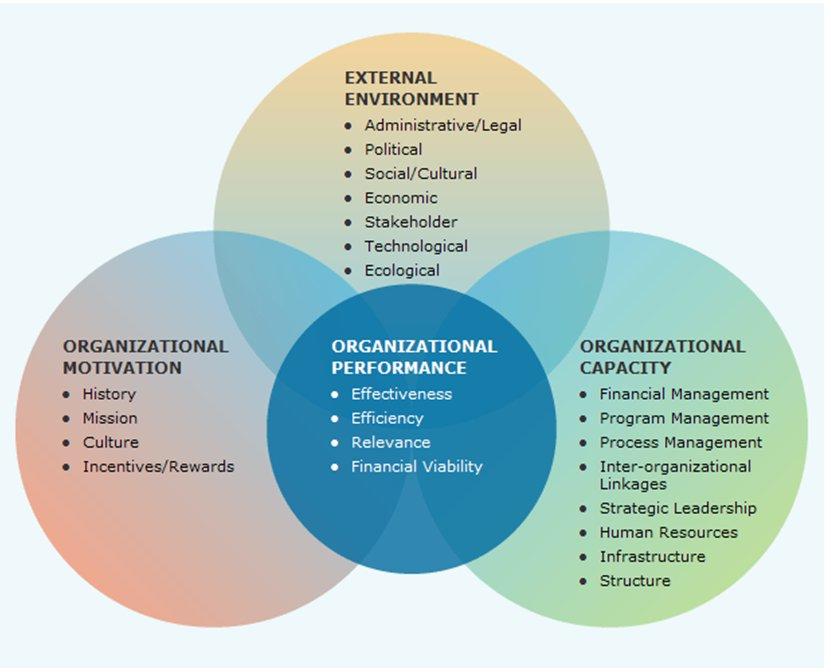
Different models have been developed to evaluate organizational performance and the key elements in each model show the responses to the effects organizational factors have towards the development of the employees (Koornneef et al., 2012). The responses should show positive employee commitment in terms of venture growth, passion, mission, vision, and self-efficiency.
Behavioral Leadership
Leadership is the key to modifying employee behavior to positively respond to the performance expectations of the organisation. Under the leadership, employees are able to stay focused to realize organizational goals because the management is able to determine and create the right environment to optimise employee knowledge and skills (Koornneef et al., 2012). Typically, people at the leadership positions provide the professional development assistance and direction to each employee to make them work by putting every energy and effort into the roles and tasks they are assigned. Yousef (2000) noted that leadership plays the advocacy roles by enabling each person to feel wanted because ideas and issues are communicated with a lot of conviction. In addition, the management contributions towards effective leadership is by modifying the perception of the employees to understand that problems sometimes provide the foundation to do other tasks in a better way.
The Impact of the Modification on the Organization Behavior
Yousef (2000) contends that different organizational leadership behavioral theories have been proposed and implemented within organisation with the hope that they can provide the expected outcomes. One such approach is to apply operant conditioning to model employee and organizational behavior. However, each element of the behavior modification process depends on the responses towards internal and external environmental factors, the knowledge or body of information that is inherent in an individual, and the necessary experience that provides the foundation for deducing the patterns on the cause and effects relationships.
Here, professional development is guaranteed by conditioning employee behavior through various methods that have been suggested in academia (Koornneef et al., 2012). Operant conditioning of employee behavior has shown evidence of increasing the morale and self-determination to work towards the goals and objectives defined within an organization.
Complexity of Development
Organisational development is a complex process that many scholars have modeled on the intellectual capabilities of the organisational development professionals who make contributions towards employee development. At the individual level, organisational development is implemented at the individual level through different coaching, mentoring, job design, job description, reflections, self-awareness tools, leadership development, 360-dgree feedback, conflict management, action learning, value creation and integration, and responsibility charting (Yousef, 2000). The individual and group interventions show how the complexity and levels of commitment of the management lead to better execution of organisation tasks and responsibilities. Here, individual skills are developed and each person makes a contribution towards the development of a team that results in team synergy. Here, tram work and leadership responsibilities when they work precisely together, lead to higher levels of commitment and better results.
According to Yousef (2000), the precision nature of decision making, the level of organizational efficiency, and better team development and maintenance practices lead to better decision making approaches and improved organizational efficiency. Better decision making strategies lead to better team development and individual performance. Each team building element when implemented collaboratively adds to the team building efforts and higher organisational efficiencies. Moreover, team development and commitment towards the organization is hierarchical in nature and more specifically has been evident in many organizations in the UAE.
In each of the team building organizational development strategies, performance enhancement happens as expected in a competitive business environment (Naem, 2014). However, it is evident in scholarly literature that to be competent in organizational development, the leadership must demonstrate competencies in organizational design, system dynamics, theories and models of change, organizational research, and ability to identify the history of organizational development. According to Yousef (2000), the core competencies that have been identified include ability of the leadership to evaluate organizational change, manage the consulting process, facilitate and process consultations, analyse and diagnose problems, and develop client capability.
Practically, organizations consist of employees who work in teams and implementing the training and development program can only be effective if training programs are implemented at the team and inter-team levels. This level of intervention has been shown to improve team cohesion, team interdependence, and the relationships among teams and team members.
Company Background
SEHA (Abu Dhabi Health Services Company) in Arabic means health. SEHA is a company that has been in operation in the UAE in for many years since it was launched in 2007. The company operates many clinics and hospitals in the UAE and the sole purpose of the company is to develop and provide curative medicine and other remedies that address a broad range of health care problems that affect the local people within the UAE and other people who seek medical services at cheaper costs from outside the country (Al Junaibi et al., 2013). It has been demonstrated that the company offers high class health care services by partnering with other internally recognised health service providers form other parts of the world. In investigation into the service providers who partner with SEHA shows a list that consists of hospitals such as Cleveland Clinic, Bumrungrad International, Hopkins Medicine, and Vamed among others.
The company was formed in response to the policies that required that each member of the UAE be covered by a comprehensive health insurance program to make the delivery of health care services cost effective and affordable by a wide range of people. In addition, the company’s policies on the provision of health care services are based on the government policy where each member or subscriber to the services makes contributions to the company. SEHA supports both private and public hospitals and has the responsibility of managing government owned health care facilities within the jurisdiction of Abu Dhabi. It is in record that SEHA manages “57 Primary Health Care Centres, 13 Hospitals, 3 Maternal and Child Health Centres, 3 Specialized Dental Centres, one centre for Autism, and 5 Specialized Facilities like rehab, blood bank and herbal centre” (Al Junaibi et al., 2013, p.2).
Services Provided by SEHA
The company operates in the UAE based on actionable data that is collected from different medical centres within the UAE. Different subsidiary companies are assigned different roles and responsibilities and each is executed with the reporting function delegated to the Dubai Health Authority (DHA), which is responsible for designing policies and strategies for providing health care services to the people (Al Junaibi et al., 2013). By operating under the Dubai Health Authority (DHA), SEHA conducts surveys on the health needs of the people, which are implemented within the UAE through comprehensive health promotion programs. The strategies and programs target the entire population with preventive and curative strategies for each target population. A survey that was conducted on 27th June 2010 by the Dubai Statistics Centre (DSC) in collaboration with the Dubai Health Authority (DHA) revealed comprehensive information that was illustrated by the Dubai Household Health Survey (DHHS) on the health status of the people in Abu Dhabi.
The survey revealed that 2500 UAE National Households were existing that were in need of medical health care services and the services were offered by 2500 expatriates and over 700 people working on the existing labour camps. Al Junaibi et al. (2013) noted that a Primary Health care Services Sector (PHCSS) survey was conducted to establish the risk factors affecting over 3,000 families for which SEHA was responsible to provide health care services. Through the survey, it was established that the company should focus on the provision of services that address the problems associated with the mental and obese problems affecting the population. In addition, the survey revealed that a significant number of people who were suffering from heart diseases need medical care that is provided by the health care expatriates. In regard to the findings, it was established that hypertension was one of the killer diseases that the company should focus on providing services. At the same time, it was established that only a small percentage of women exercise and the majority do not. An increase in the cholesterol levels in the blood was noted among the women in the UAE and investigation of the body mass index among women in the country was noted to be higher than the normal allowed for the body. Other indicators that demonstrated the existence of medical problems within the population were high blood pressure and the effects of smoking.
According to Al Junaibi et al. (2013), most of the health care services offered by the company include hair transplantation because the company has the machines and expertise to offer the services. In addition, the facilities offer less labour intensive hair transplantation for the people who suffer from baldness. Other issues that are addressed within the company include hair cloning, hair multiplication services, and the provision of techniques that enhance hair distribution and multiplication on the bald head. Gene therapy is a new area of specialisation that the company intends in make investments in because of the increasing demand for gene transplantation that allows for consistent growth of the hair by hindering the cells that have been destroyed by DHT hormone from interfering with the growth of the hair. However, an analysis of the health care personnel showed that despite the presence of highly skilled people who can provide advanced services, there was a serious problem of employee commitment to the provision of health care services.
Vision, Mission and Values
According to Al Junaibi et al. (2013), the mission and vision statements are as follows:
- Vision: To provide the people with medical services that satisfy their needs and expectations that surpasses the international standards.
- Mission statement: To transform the service delivery of the medical services in the UAE by continuously improving patient care to measure up international standards requirements.
- Values: The professional members of the organisation always strive to reduce time wastage and value patient time. Compassion, service delivery, safety, and close attention to operating procedures to offer evidence based care for those in need of the medical services.
The company works by considering the core values that drive the medical profession. Patients are always given due attention and the management and other staff members always strive to reduce the time required to attend to the patients while offering high quality services at the lowest cost. In addition, to improve the quality of health care services being offered by the company, SEHA has established various connections with different institutions that offer high quality services throughout the word to bring the more advanced services to the people close at home. The company also partners with different government bodies to formulate policies and guidelines that help to facilitate service delivery for the people in need of the services.
Research Design and Methodology
Typically, the nature of this research project, it was critical to identify the right research methods to apply to answer the research questions. The qualitative research paradigm was combined with the quantitative research paradigms. Each paradigm showed evidence of the beliefs and the framework within which the research was conducted. Both research approaches made significant contributions towards the research project by optimizing in the advantages of each research method to overcome the weaknesses inherent in each paradigm. The qualitative approach is defined as “an inquiry process of understanding a social or human problem, based on building a complex, holistic picture, formed with words, reporting detailed views of informants, and conducted in a natural setting” (Feilzer, 2010, p.2).
In this case, the qualitative paradigm enabled the researcher to interpret the findings in a naturalistic environment by enabling the researcher to study the phenomena in detail. In each step of the qualitative paradigm, it was evidently shown that the process factored a descriptive focus anchored on empirical exploration of facts, enabled the researcher to identify the emerging patterns, focused on the use of the people as the research instruments, and enabled and inductive analysis to be done on the research findings. In each case of the qualitative inquiry, it was important for the researcher to commit a lot of time in the field of study to collect extensive data that was analysed to address the research problem. In each analysis case, evidence was adduced based on empirical facts to make the conclusions drawn from the data more reliable.
According to Feilzer (2010) the main advantages that made the research paradigm reliable is that it enabled the researcher to use subjective information in the study, the study was not limited to the rigid requirements that the qualitative research paradigm is usually subjected to, the approach enabled the researcher to investigate the solutions to the problems using value laden questions, and it enabled the study to build on excising theorist hast explain the phenomena of the relationship between training and development and employee commitment to their work related tasks. Empirical evidence was derived for the study by using statistical means to analyse the data that provide the foundation to address the research problem on the effects of training and development on employee commitment and the resulting effects on the organisational performance (Feilzer, 2010). Here, mathematical expressions provided empirical evidence because of the use of percentages derived from statistical analysis of the available data. In each case of the study, the paradigm enabled the researcher to model the study, use tools that have been proved to be reliable, collect empirical data, and to model and analyse the data.
Data Collection
Data collection was done by issuing out questionnaires to collect primary data. Questionnaires were administered with the help of the employees of the SEHA Company with the assistance of the management that created time for the employees to assist in data collection. The questionnaires were collected and cleaned before the data was keyed in the SPSS software for analysis. Data cleaning was important because it enabled the researcher to remove those questionnaires that had multiple answers or that were wrongly answered from those that were correctly answered to be assured of using the correct primary data (Feilzer, 2010). On the other hand, the sources of secondary data were research articles, the company’s records, books and other sources that were made available during the study.
Sampling
Different sampling methods were evaluated to identify the most appropriate for this study. The underlying concept was to collect the right sample that could be representative of the target population and ensure that the results were valid. The rationale for sampling was that it was deemed to be economical and provided the data to analyse within a very short time. In addition, sampling was identified as the best option to use because scholars argue that samples are more accurate than to use a census, which could provide less accurate and reliable data (Feilzer, 2010). In addition, it was established that sampling could enable the researcher to get access to more detailed information that could address the research problem more exhaustively, and the approach was based on empirical evidence that was derived scientifically.
To address the sampling errors that happen in any research settings when using the sampling strategy, the researcher first identified the errors that were likely to happen. Among the errors that could happen include failure of the respondents to provide answers as required, low commitment of the respondents to answering the research questions, and biasness when collecting data (Feilzer, 2010). The strategy that was used to address the problems was to identify the right data collection methods, informing the participants in advance the purpose of the study, and requesting them to be as candid in their responses as possible.
A sample calculator was used to determine the sample size from the target population. A sample size of 130 people was collected and a confidence level of 95% was targeted for the study with a confidence interval of 15. The target population was 1950 and that yielded a sample size of 130 participants (Feilzer, 2010). The participant selection strategy was based on random sampling method because each member of the population had the equal chance of participating.
Limitations
The researcher experienced time constraints, which necessitated the investigation to use more resources to collect enough data for analysis.
Some participants were dishonest in giving answers and some did not answer some of the questions.
Analysis and Interpretation of Data
Different questions were asked the respondents and the answers were enumerated and analysed using the SPSS software. The results were then expressed in tabular form for each question that was asked the respondents.
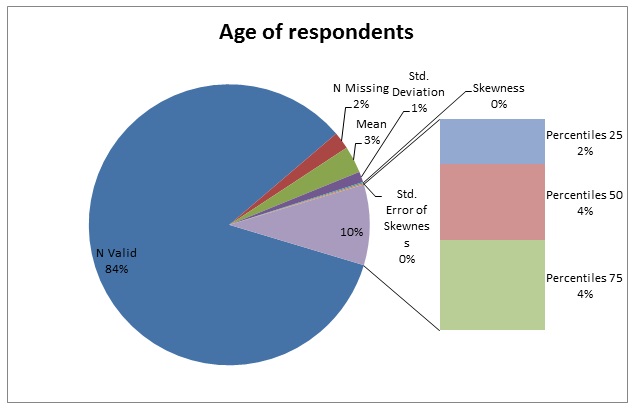
Question one provides responses to the general questions on age and gender and how the factors were distributed among the participants. It is clear from the table that some participants did not answer the questions on their status.
Is the study representative of the demographic profile of employees?
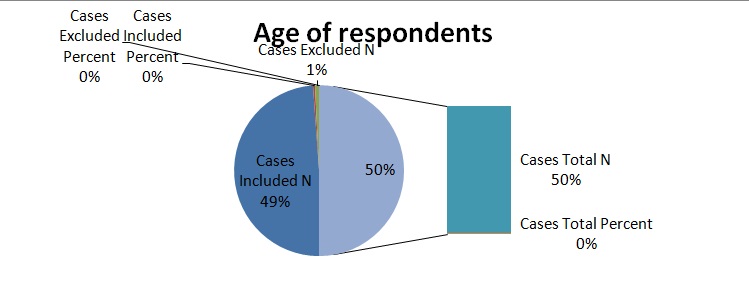
The response for question 2 focused on age of the respondents, gender, and educational levels. Each category was answered and only 1.5% did not respond on age, 1.5% did not respond on gender, and 8% did not respond on educational levels.
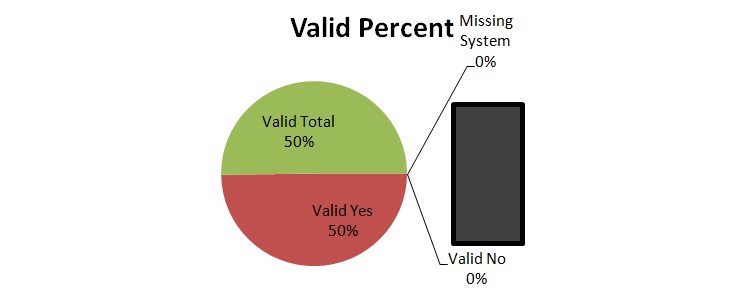
Question 3 was posed to the respondents to determine whether they were UAE. The results showed that 94.6% were from the UAE and a cumulative percentage of 99.2% showed that the respondents were from the UAE. However, 1 person did not respond on their citizenship that was equivalent to 4.4%. Here, the category of respondents belongs to the local citizens only.

The table shows the correlation between training and development and training and organizational performance. It is illustrated in the table that training and development show negative t values, which means that in the absence of the training program, the effects on development are extreme. In addition, development shows a negative values, which shows that lack of training has a negative effect on the development of the employees, because the t (-3.419) value is negative.
The table shows that a correlation exists between training and development programs which are significant at the 0.01 level (2-tailed) of.972. The significance level of 0.01 or 1% and the results show that the results are highly reliable because only 1% of the responses could be erroneous and the rest 99% is reliable.
Is there a relationship between employee training and commitment?
Again the results show a correlation which is significant at the 0.01 level (2-tailed) with a (p<0.01) or less than 1%. There is a significant relationship between training and employee commitment to the organisation. The results show that less than 1% of the responses could by change be accidental and over 99% are reliable. The significance level is on a 2 tailed test, which shows that the results on employee training and commitment to the organisational goals and objectives.
Do employee training programs improve the performance of the organisation?
A Pearson correlation shows a strong correlation between employee training and performance outcomes. The responses were analysed and established to significant at the 0.01 level (2-tailed). In each case, the Pearson correlation is 723, which shows that training has a strong positive effect on performance outcomes. The reliability of the results is based on 99% confidence because of the significance level being 0.01 or 1%. On the other hand, the results can be interpreted to mean that when employees are not subjected to any training program to improve their skills and knowledge, performance is likely to drop.
Does the company have training and development policies?
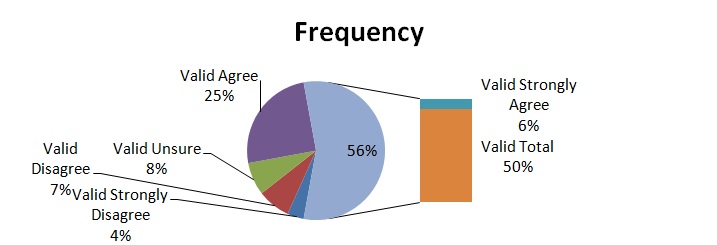
Training is one of the core components and tools that can be used to modify employee behavior and commitment to the organization. This question was focused on collecting data on the responses of different employees on the existence of policies that provide guidelines for the training and development programs across the organization. The goal was to determine the percentage responses for each item in the questionnaire. The results show that 50% of the participants agree on the need for training and development programs. On the other hand, 7% strongly disagree on the need for a training program to develop employee knowledge and skills and increase their commitment to the organization, which leads to better organisational performance.
Are employees offered the opportunities to train under specialised experts?

The responses show that 53% of the respondents agree that the organization provides various training opportunities for the employees under skilled and well trained experts for skills and knowledge transfer while 11% strongly agree. On the other hand, 9% of the respondents strongly disagree that they have been exposed to the training and development programs tailored to meet employee skills development goals. However, 17% were unsure and 21% of the participants disagree that training and development programs or policies exist that offer opportunities for the training and development of employees.
Are you satisfied with the frequency of employee training programs?

Employees show in the tabulated results that 53.8% agree with the frequency of the training and development programs and 23% strongly agree with the training and development program. However, it is evident that 15% strongly disagree that the training and development programs are not frequently run within the organisation and 7.7% disagree. On the other hand, 5% were not sure of the existence and frequency of training programs. For employees to be competent, it is necessary for them to be taken through the training and development programs frequently and in response to the skills needs in a highly innovative and competitive business environment.
Does the management get involved in supporting the training and development program?
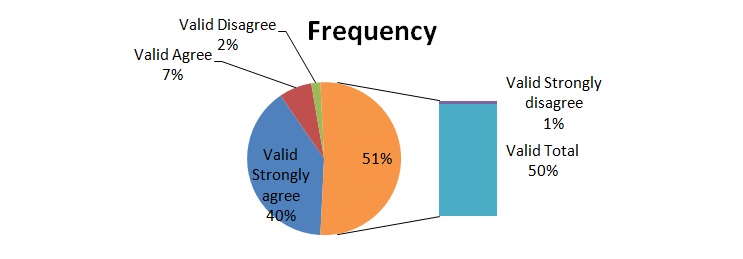
The statistical response on management involvement in organizational development programs shows that 79.2% strongly agree with management support and involvement in organizational development. On the other hand, 14.4 % agree that the management gets involved in supporting organizational development and 3.2 % disagree and 3.2% of the participants strongly disagree. Organizational development is a key component for employee development that managers use to organise train and development operations within the organisation. Part of the organizational development processes is needs assessment, which is necessary for employee training and development programs that organizational managers use increase employee motivation and self-awareness.
Do organizational development programs exist for the management to improve employee commitment and organizational performance?
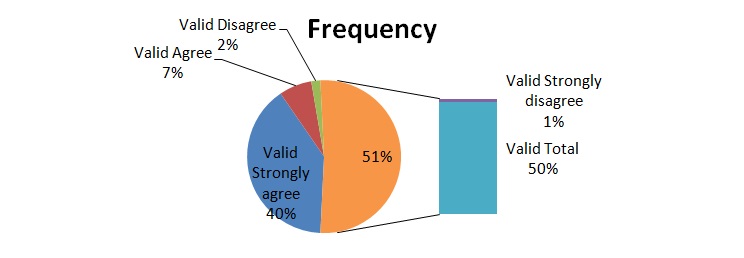
Organizational development is a critical component that managers use to transform the performance of the organization through employee training and development programs to be among the long term and short term efforts to bring out change. The management direct steps in a collaborative manner with the employees at different levels of the organization. The results indicate that 72.5% of the participants agreed that the organization has in place organizational development programs and 15.2% agree. However, it is clear that 4.8% of the strongly disagree that organizational development programs are in place and 7.5% disagree that such a program exists for managers to use to implement training and development programs. A critical analysis of the findings in context of the qualitative findings shows that the managers implement the programs is the individual, group, and intragroup levels. In each case, employees are the beneficiaries of the program because it leads to higher levels of commitment that enables them to work to improve the performance of the organization as a net result. The program must address the beliefs, values, and behaviors by positively influencing them through the training and development programs as part of the organizational development strategies.
Are the organizational development elements of coaching, and mentoring self-awareness lead to sustained employee commitment and improved performance?

The question has several variables that have been combined together to provide a clear view to the respondent on what was expected as a result of the study. The link among the effects of coaching, mentoring, and self-awareness and commitment with performance outcomes clearly indicates that employee value the elements because of the contributions such elements make towards achieving employee training and behavior modification requirements. According to the responses, 70% strongly agree that the elements are necessary, 20% agree, 6.9% disagree, and 3.1% strongly disagree. Based on the literature review and qualitative findings and the quantitative findings on the table, it is evident that coaching, self-awareness, and self-mentoring are crucial for behavior modification that leads to sustained commitment and better organizational performance. The findings are consistent with qualitative findings that show that behavior modification through organizational development programs that are implemented through the training and development programs can be achieved by encouraging employees to develop positive attitudes, valuing their beliefs about commitment to the work related practices, developing an open mind to instructions, relating well with other employees, communicating effectively among the employees, establishing confidence in themselves, being aware by developing intuition agouti the environment, and using self-assessment strategies to solve problems that arise at the place of work.
Can the training and development programs improve employee level of commitment?
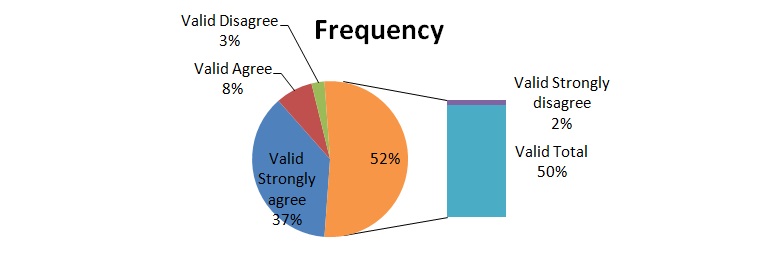
Training and development underpins employee behavior modification strategies that lead to better employee commitment at the place of work. The results on question 14 shows that 74.4% of the people strongly agree with the training and development program have a positive effect on employee commitment to the place of work.
Are you confident of that the training and development program address your personal development goals and objectives?
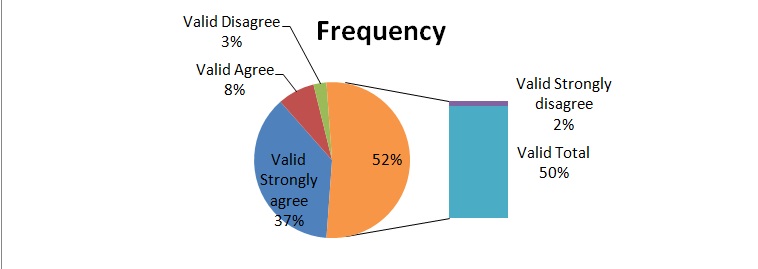
Employee development programs are tailored to address the needs and expectations of the employees at the place of work in the context of personal development goals such as career development objectives.
Discussion, Observation, Conclusion and Recommendations
Discussion
It was established from the study that there was a fair distribution of respondents across the demographic divide of the employees. The results showed that employees within the organization were fairly represented, making it possible to replicate the results across the target population. On the other hand, the responses showed that the participants were local peoples and that reflected strongly the training needs of the employees who work for the organization.
Responses from the employees on their knowledge on the effects of training and development and the correlation the elements have towards the performance of the organisation showed that a significant correlation existed among the elements. In addition, it was demonstrated in the study that training had a sting effect on the performance of the organisation because most employees under the training and development programs were subjected to the skills and knowledge required to equip them with the abilities to improve organizational performance. Training enables employees to work hard within the organisation and that reduces the costs incurred because of time wasted working with unskilled employees. In addition, training inspires confidence in the employees and that motivates them to work towards the success of the organisation.
A strong correlation was noted between training and development as the statistical evidence presented in question five shows. On the other hand, it is clear from subsequent responses that employees strongly agree that the company has a training and development programs that run frequently and most of the programs are tailored to address personal development needs. In addition, it was evident from the responses that the management provides support for organizational development programs that evidently are supported by the government and implemented with the support of other government institutions such as the Ministry of Health (MOH) that supports both private and public clinics and the Dubai Health Authority (DHA) that provides the same services in the Emirate of Dubai.
Observation
The study provided the foundation for future research and effective strategies for improve the training and development programs to modify employee behaviors and attitudes and commitments towards the organizational operations. Here, the participants were open-minded and positive about the study because it revealed the areas to focus on.
Conclusion
Training and development programs are crucial components that SEHA managers can implement at the individual, teams/group, and organizational levels to modify employee attitudes and behaviors to inspire commitment in them to work in driving the organization to achieve its short term and long term performance goals in the provision health care services for the local people and those who come from different parts of the world. Training and development can best be achieved through management commitment in implementing organizational development plans based on a strong commitment of competent organizational managers and those in the management hierarchies. Different training and development and organizational development strategies have been suggested at different levels of the organization. Some of the suggested employee behavioral modification programs that are informed by the social learning theory for conditioning the mind include coaching. Organizational development professionals and the managers use coaching as an intervention strategy to establish and interactive environment to training employees on how to perform various tasks with higher levels of efficiency and commitment. The main areas of focus when coaching employees include establishing partnerships, enacting vision, speaking and acting, and practicing hat has been taught.
Recommendations
A systematic analysis of both qualitative and quantitative findings show that organizations should focus on the antecedents of behavior modification and behavior change theories that explain how the training and development programs can best be used to modify behavior and improve employee commitment and organizational performance.
Mentoring on the other hand is implemented by developing an interactive relationship with the mentor, listening and acting on feedback, and getting committed to perform the assigned tasks efficiently. Here, self-awareness on the other hand is done through dialogue and other mechanisms that the management identifies to be appropriate.
References
Al Junaibi, A., Abdulle, A., Sabri, S., Hag-Ali, M., & Nagelkerke, N. (2013). The prevalence and potential determinants of obesity among school children and adolescents in Abu Dhabi, United Arab Emirates. International journal of obesity, 37(1), 68-74.
Armstrong, M., & Taylor, S. (2014). Armstrong’s handbook of human resource management practice. New York: Kogan Page Publishers.
Dessler, G. (2003). Human Resource Management (9th ed.). New York: Prentice Hall.
Feilzer, M. Y. (2010). Doing mixed methods research pragmatically: Implications for the rediscovery of pragmatism as a research paradigm. Journal of mixed methods research, 4(1), 6-16.
Hajat, C., & Harrison, O. (2010). The Abu Dhabi cardiovascular program: the continuation of Framingham. Progress in cardiovascular diseases, 53(1), 28- 38.
Harzing, A. W., & Pinnington, A. (2010). International human resource management. New York: Sage.
Ivancevich, J. M. (2010). Human Resource Management (11th ed.). New York: McGraw Hill
Koornneef, E. J., Robben, P. B., Al Seiari, M. B., & Al Siksek, Z. (2012). Health system reform in the emirate of Abu Dhabi, United Arab Emirates. Health policy, 108(2), 115-121.
Naem, M. (2014). Social Entrepreneurship: An effective mode of promoting Public Private Partnership in Middle East. Asia Pacific Journal of Management & Entrepreneurship Research, 3(2), 5.
Yousef, D. A. (2000). Organizational commitment: a mediator of relationships of leadership behavior with job satisfaction and performance. Journal of Managerial Psychology, 15 (1), 6-28
Appendix
What is the gender demographics distribution of the participants?
- Please select your gender
Male_______Female______ - What is your age_____________?
- Please mark against your educational status
Diploma_____Degree_____None___
Is the study representative of the demographic profile of employees?
Yes_____No_____
Are you a local resident of the UAE?
Yes______No_____


